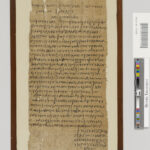| Artefact ID | 151 |
| TM ID | TM 33624 |
| Findspot (DEChriM ID) | 58 (Dayr al-ʿIẓām) | Class | Textual |
| Material | Papyrus |
| Writing medium | Sheet/roll |
| Text content | Documentary |
| Language | Greek, Coptic |
| Archive/Dossier | Archive |
| Description | P.Amh. II 145; Chrest. Wilck. 53: Letter from Apa John. Almost complete sheet of well-preserved papyrus although a very thin strip is missing on the left. It contains a letter addressed by Apa John to a man named Paul. While the body of the letter is in Greek, Apa John's signature, in the last five lines, is in Coptic. Long-winded apologies and salutations occupy a great part of the letter, the chief point of which is a request for money on behalf of a certain Makarios. The letter is written in a thick cursive hand – the last line before final greetings in Coptic uncials being written in a different hand. Careful layout with indentations in address and final greetings. The anchorite of this archive was identified by Zuckerman 1995 with the famous John of Lycopolis known by literary sources. According to Fournet 2020: 53, the final salutation serving here as a signature in Coptic indicates that Apa John dictated the message, and “signed” in the only language he knew, Coptic (see also Zuckerman 1995: 189-190 and Chrest. Wilck. 53, intro.). But like the first editors (P.Amh. II 145, intro), Van Minnen (1994: 84) maintains that the Greek text is written by the same hand as the Coptic subscription, and Choat assumes that one cannot exclude that "the Johannes who sent P. Amh. II 145 was fully conversant in writing and speaking both languages" (2017: 66-68). The verso must be blank. |
| Selection criteria | Christian terms/formulas/concepts, Coptic language |
| Date from | 375 |
| Date to | 425 |
| Dating criteria | Palaeographically dated to the late 4th or early 5th c. Note that the range of Apa John's archive is generally dated c. 375-399. |
| Absolute/relative date | Relative date |
| Archaeological context | Re. the acquisition of this letter, Choat (2017: 38; n. 118) notes: "This letter was part of the same purchase by Grenfell and Hunt which included the archive [of Apa John], but was among the papyri from that winter’s purchases given to Lord Amherst, for whom Grenfell and Hunt were buying papyri”. He concludes: "It is thus highly probable that it comes from the same archive". According to Constantine Zuckerman's reconstruction, the Apa John’s letters were presumably found in September 1897, during the excavations of Farag Ismael and Yassa Tadros on the mountain of Siout (Lykopolis), in the ruins of Dayr al-'Azam, the site of the monastery of John of Lykopolis. Yet, they never reached the museum in Gizeh – like the other objects unearthed during these excavations – and must have ended on the market, where they were bought soon after the excavations (Zuckerman 1995: 189-192). Although not proven, this attractive hypothesis is generally accepted by scholars (see discussion in Van der Vliet 2015: 166-167, and some reservations in Choat 2017: 37-40). |
| Accession number | New York, Pierpont Morgan Library Dept. of Medieval and Renaissance Manuscripts, Manuscript Amh. Gr. Pap. 145. |
ARTEFACT IDENTIFIERS
Editio princeps
• Grenfell, Bernard P. and Arthur S. Hunt. 1901. The Amherst papyri, Being an account of the Greek papyri in the collection of Lord Amherst of Hackney, Vol. II: Classical Fragments and Documents of the Ptolemaic, Roman and Byzantine Periods. London, no 145.
Additional bibliography
• Choat, Malcolm and Maria Chiara Giorda. 2017. Writing and Communication in Early Monasticism. Texts and Studies in Eastern Christianity 9. Leiden, Boston.
• Fournet, Jean-Luc. 2020. The Rise of Coptic: Egyptian Versus Greek in Late Antiquity. The Rostovtzeff Lectures Book 1. Princeton.
• Naldini, Mario. 1968. Il cristianesimo in Egitto. Lettere private nei papiri dei secoli II-IV. Studi e Testi di Papirologia. 3. Firenze: Le Monnier, no. 49.
• Van der Vliet, Jacques. 2015. “Snippets from the Past: Two ancient sites in the Asyut Region: Dayr al-Gabrawi and Dayr al-’Izam.” In Christianity and Monasticism in Middle Egypt, ed. Gawdat Gabra and Hany Takla. Cairo: The American University in Cairo Press, 161-168.
• Van Minnen, Peter. 1994. “The Roots of Egyptian Christianity.” Archiv für Papyrusforschung und verwandte Gebiete 41, 71-85.
• Zuckerman, Constantine. 1995. "The Hapless Recruit Psois and the Mighty Anchorite, Apa John." Bulletin of the American Society of Papyrologists 32, 183-194.
• Wilcken, Ulrich. 1912. Grundzüge und Chrestomathie der Papyruskunde, I Bd. Historischer Teil, II Hälfte Chrestomathie. Leipzig-Berlin, 77, no. 53.


 Json data
Json data




